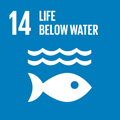- Docente: Alessia Cariani
- Credits: 6
- SSD: BIO/05
- Language: Italian
- Teaching Mode: In-person learning (entirely or partially)
- Campus: Ravenna
- Corso: Second cycle degree programme (LM) in Marine Biology (cod. 8857)
-
from Nov 04, 2024 to Dec 18, 2024
Learning outcomes
At the end of the course the student possesses advanced knowledge on the genetic structure patterns of marine populations, the processes that define them in the spatial and temporal dimensions and the correlated demographic parameters. The student acquires the skills to identify and describe the evolutionary and environmental drivers of the biodiversity of marine populations, in particular the mechanisms of selection of adaptive and neutral traits in the marine environment and the functional role of these processes. In particular, the student is able to: estimate the connectivity levels between natural marine populations and the identification of adaptive traits through the comparative study of the variation of neutral and under-selected markers; identify and critically describe the role of connectivity in determining the structure, distribution and abundance of species in space and time; analyze dispersion processes in relation to the structure of marine communities, the dynamics of local populations and meta-populations, biogeographical patterns and the resilience of populations subject to stress.
Course contents
Lectures (4 ECTS)
Conceptual bases: Paradigms of dispersal, connectivity and structure of marine populations and changes related to scientific advances. Microevolutionary forces affecting marine populations. Relationships among environmental, ecological and reproductive (genetic) factors and impact on genetic diversity and differentiation of marine populations.
Technological tools: Molecular markers and statistical tools for data analysis. Introduction to biochemical markers. Theoretical and applicative baseline on the nature and variation of molecular markers, development and analysis of genetic-molecular markers. Methodological introduction to massive sequencing technologies, focusing on advantages and limitations of different platforms and methods and providing an introduction to data analysis approaches of polymorphisms at the genomic level. These technological tools will be further explored during the planned lab practical, which will include both practical activities on basic molecular techniques and sessions on genetic and genomic data analysis.
Pylogeography and historical demography of marine populations: relationships among geographical genetic variation, species/population distribution and historical demographic changes of marine populations.
Genetic structure and connectivity of marine populations: relationships among spatial population genetic variation and structure, connectivity, natural selection and environmental/ecological factors.
Temporal changes in marine populations: relationships among temporal genetic variation and demographic changes in marine populations
Empirical case studies illustrating the aforementioned relationships in invertebrate and vertebrate marine organisms and their impacts, with a focus on:
- Identification of population units for sustainable exploitation and conservation
- Genetic herosion and stock depletion
- Traceability of origin at the population and individual levels. Examples of forensic applications
- Parentage analysis and assignments. Applications in biological conservation and aquaculture
Lab practicals (2 ECTS)
Wet Lab practical. Molecular-genetic markers and methodologies for the analysis of the structure and connectivity of marine populations: design of analysis drawings, sampling and conservation techniques, practical exercise on basic methodologies for the analysis of molecular variation (DNA extraction, gene amplification, agarose gel electrophoresis, DNA sequencing, genotyping of individuals).
Hands on data analysis practical (DryLab)
DryLab1. Genetic data analysis to assess microevolutionary patterns and processes of geographical population structuring: mtDNA variation analysis, genetic distance estimate, reconstruction of phylogenetic trees, boostrap analysis, comparative phylogeographic analyses, identification of cryptic species.
DryLab2. Modelling temporal genetic changes in marine populations under the microevolutionary forces as migration, genetic drift, population size, natural selection. Estimate of genotype and allele frequencies, estimate of fixation indexes, analysis of molecular variance, permutation test.
DryLab3. Genetic data analysis to assess ecological/environmental patterns and processes of structuring in marine populations: microsatellite analysis, learning and use of tests and software for population-based and individual-based genetic analysis.
DryLab4. Genetic data analysis to assess ecological/environmental patterns and processes of structuring in marine populations: Single Nucleotide Polymorphism analysis, learning and use of tests and software for population-based and individual-based genetic analysis.
DryLab5. Analysis of genetic data to estimate ecological patterns of marine population genetic structure with R environment.
Readings/Bibliography
The course does not use textbooks because of the highly specialized contents. All scientific papers and illustrated and discussed within lectures and lab practical sessions will be provided to students.
Teaching methods
Lectures
Individual lab practical sessions to give basic molecular markers and bioinformatic data analysis skills.
Assessment methods
Written test with open questions, including data analysis exercise.
Reports on individual lab practical session are recommended. They are not compulsory; however, lecturers and instructors could consider them for the final evaluation.
Teaching tools
Scientific articles and reviews illustrating topics, advances and case studies; slides; thematic monographs.
Laboratory methods and handouts for molecular Wet Lab practical
Handouts, data sets and free-user software for bioinformatic data analysis Dry Lab practical sessions
Office hours
See the website of Alessia Cariani
SDGs


This teaching activity contributes to the achievement of the Sustainable Development Goals of the UN 2030 Agenda.
